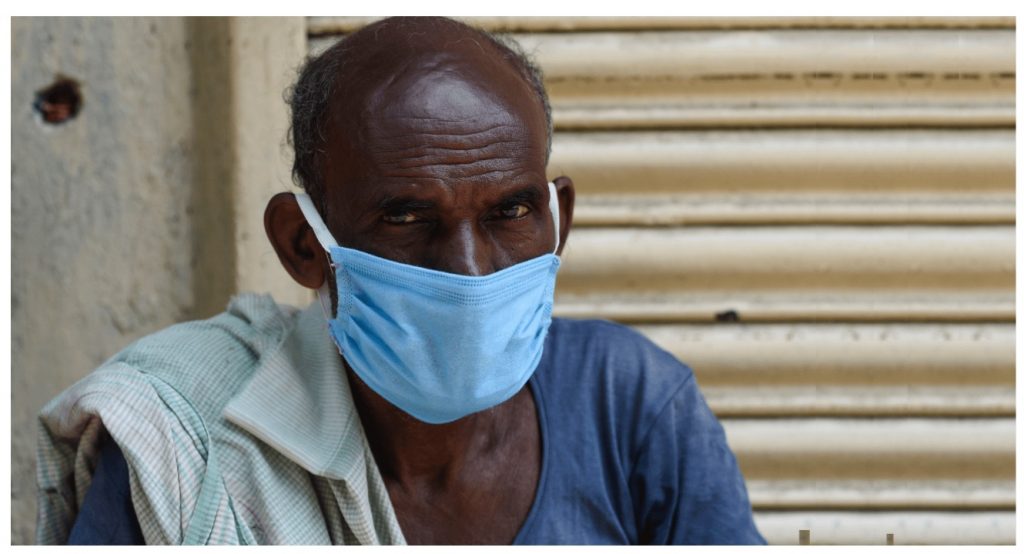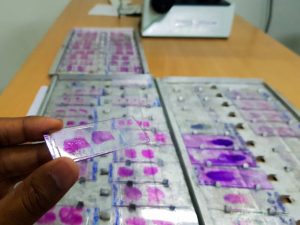By James D. Agresti
Overview
With one exception, every gold standard study of masks in community settings has failed to find that they slow the spread of contagious respiratory diseases. The outlier is a widely cited study run in Bangladesh during the Covid-19 pandemic, and some of its authors claim it proves that mask mandates “or strategies like handing out masks at churches and other public events—could save thousands of lives each day globally and hundreds each day in the United States.”
In reality, the authors altered their study to exclude the data that could prove or disprove that very claim. This is a blatant violation of research ethics, and it biases the study to hide the harms of masks, which are far more common and serious than portrayed by governments and media outlets.
Study Design
The Bangladesh mask study, published by the journal Science in December 2021, was a “cluster-randomized controlled trial.” In plain language:
- randomized controlled trials (RCTs) are studies in which people are randomly assigned to receive or not receive a certain treatment, like wearing a mask. This allows the study to control for every possible confounding factor, something that “is not possible with any other study design.” Thus, clinical research guides call RCTs the “gold standard.”
- cluster RCTs involve giving “the same treatment” to people who interact with one another, whether it be households, villages, workplaces, etc. This is useful for studies on masks because the “prevention of one infection in an individual can prevent a chain of subsequent transmission” to others.
In short, the basic study design was ideally suited to determine if masks work, but as will be shown, the execution and interpretation are not.
Excluding the Death Data
As required by research ethics, the authors of the Bangladesh mask study published a pre-analysis plan explaining how their RCT would be conducted and what it would measure. Pre-analysis plans are a tool to prevent biased or dishonest researchers from changing the goal posts after results begin to pour in. Per the journal Epidemiological Reviews:
In designing the protocol of any clinical trial conducted today, there would be a requirement that the endpoints and case definitions be clearly laid out in advance. In fact, regulatory authorities hold the investigators to these predetermined endpoints to avoid what is sometimes termed “data dredging,” or looking for those outcomes for which significant differences would be found.
Likewise, an article from the World Bank’s Development Research Group explains that the primary reason for pre-analysis plans “is to avoid many of the issues associated with data mining and specification searching by setting out in advance exactly the specifications that will be run and with which variables.”
The pre-analysis plan for the Bangladesh mask study states that it will measure “hospitalizations and mortality,” but these measures are completely absent from the study results. This is a flagrant breach of research ethics, and it obscures the only data that can objectively prove whether masks save or cost lives on net.
Import of the Death Data
To accurately measure the impact of masking or any other medical intervention on death, one has to measure actual deaths—not some other variable. This is because measuring whether masks prevent C-19 infections, as the Bangladesh study does, doesn’t measure how many people died from C-19 or any of the lethal risks of masks identified in medical journals, such as:
- cardio-pulmonary events.
- elevated CO2 inhalation, which can impair high-level brain functions and lead to fatal mistakes.
- social isolation, which can lead to drug abuse and suicide.
- heat, humidity, and other discomforts of wearing a mask, which can cause increased error rates and response times in situations where mental sharpness is vital to safety.
Only RCTs that measure deaths can capture the net effects of all such factors. That’s why medical journals call “all-cause mortality” in RCTs:
- “the most objective outcome” (Journal of Critical Care)
- “the most relevant outcome” (The Lancet Respiratory Medicine)
- “the most significant outcome” (JAMA Internal Medicine)
- “the most important outcome” (PLoS Medicine)
- “the most important outcome” (Journal of the National Medical Association)
- “the most important outcome” (International Journal of Cardiology)
- “a hard and important end point” (JAMA Internal Medicine)
Unlike other data which can be easily manipulated through statistical tampering, all-cause mortality in RCTs is straightforward and solid. If an RCT is large enough and properly conducted, a simple tally of all deaths among people who receive and don’t receive a treatment proves whether the treatment saves more lives than it takes. This gets more complicated for cluster RCTs, but it is still a clear-cut process.
The Excuses
Because the lead and final authors of a clinical study are most responsible for it, Just Facts asked Yale economics professors Jason Abaluck and Ahmed Mushfiq Mobarak why they flouted their pre-analysis plan to measure deaths. As documented in this full record of the email exchange, they gave counterfactual answers and then failed to reply after they painted themselves in a corner.
In a key part of the exchange, Abaluck claimed:
Collecting mortality data would have required us to revisit every household at endline in order to survey them (we only collected blood from the small subset of households symptomatic during our study period). Given the nationwide lockdown that went into effect, another round of revisits would have been prohibitively expensive and complicated, and we prioritized the other outcome variables where we had much better hope of being statistically powered.
Directly quoting the authors’ working paper, Just Facts asked:
Given that your team was “able to collect follow-up symptom data” from “98%” of the individuals in the study, why would they need to “revisit every household at endline to survey them”?
Likewise, the working paper reveals that their study “surveyed all reachable participants about Covid-related symptoms” and then used the data to calculate that masks reduce the risk of “Covid-like symptoms.”
During the very same surveys, they could have easily asked the participants if anyone in their household died. In fact, the authors may have done that, because they wouldn’t answer these questions:
Did you collect mortality data during any part of the study before the endline? If so, would you share it?
Just Facts asked those straightforward questions twice, but the authors did not reply.
Other Issues
Beyond excluding the death data, the authors engaged in other actions that reflect poorly on their integrity. One of the worst is touting their findings with far more certainty than warranted by the actual evidence. For example, some of the authors wrote a New York Times op-ed declaring that “masks work,” a claim undercut by the following facts from their own study:
- Their study’s “primary outcome,” a positive blood test for Covid-19 antibodies, found that less than 1% of the participants caught C-19, including 0.68% in villages where people were pressured to wear masks, and 0.76% in villages that were not. This is a total difference of 0.08 percentage points in a study of more than 300,000 people.
- Their paper lays down 4,000 words before it reveals the sampling margins of error in the results above, which show with 95% confidence that:
- surgical masks reduced the relative risk of catching symptomatic C-19 by as much as 22% to not at all.
- cloth masks reduced the risk of catching symptomatic C-19 by as much as 23% or increased the risk by as much as 8%.
- “Not statistically significant” is the common term used to describe study results that aren’t totally positive or totally negative throughout the full margin of error, like the results above. Yet, the authors skip this fact in their op-ed and bury it in their paper, writing at the end of an unrelated paragraph that it showed “no statistically significant effect for cloth masks.”
- Their analysis doesn’t quantify any of the uncertainty caused by the fact that they only tested 3%, or 10,790 of the study’s 342,126 participants. This tiny sample may not reflect the other 97% because:
- the study didn’t attempt to test people for Covid-19 unless the “owner of the household’s primary phone” reported that a member of their household had symptoms like a fever, sore throat, fatigue, and headache.
- 60% of the people who reportedly had symptoms did not submit to a Covid-19 test.
- Their analysis assumes that the following “mask promotion interventions” had no effects on the objectivity or willingness of participants to accurately report symptoms:
- Making them watch “a brief video of notable public figures discussing why, how, and when to wear a mask.”
- Sending them “twice-weekly text message reminders about the importance of mask-wearing.”
- Asking them to make “a verbal commitment to be a mask-wearing household.”
- Asking “them to place signage on doors that declares they are a mask-wearing household.”
- Giving a “monetary incentive” of 190 U.S. dollars to “the village leader” if at least 75% of the village adults wore masks.
- Like their paper, their op-ed states that “people over age 50 benefited most, especially in communities where we distributed surgical masks,” but this “does not suggest that only older people need to wear masks, but rather that widespread community mask wearing reduces Covid-19 risk, especially for older people.” However, their pre-analysis plan to measure results for “each decade” of age ranges shows no statistically significant effects among people aged 18–29, 30–39, 40–49, and 70+. Furthermore, they excluded this breakdown from their paper and relegated it to a supplement.
- Their paper engages in the dishonest practice of data dredging by featuring results that were not included in their pre-analysis plan, like “imputing symptomatic-seroprevalence for missing blood draws.” This allows them to transform statistically insignificant results into significant ones.
- Their analysis uses complex analytic strategies like a “generalized linear model with a Poisson family and log-link function,” evoking these warnings from academic works:
- “Manipulation of data involves subjecting data to multiple statistical techniques until one achieves the desired outcome.”
- “A general principle of data analysis recommends using the most appropriate, yet simplest, statistical techniques in research so findings can be better understood, interpreted, and communicated.”
- Statistical “malpractice typically occurs when complex analytical techniques are combined with large data sets. … Indeed, as a general rule, the better the science, the less the need for complex analysis….”
Summary
Based on their study’s finding that “mask-wearing” was 13% in villages that were not pressured to wear masks and 42% in those that were, the authors extrapolated their results to claim that:
- “if everyone wore masks, the reductions in Covid-19 cases would most likely have been substantially larger.”
- “our best estimate is that every 600 people who wear surgical masks in public areas prevent an average of one death per year given recent death rates in the United States.”
Those claims are based on shaky statistics laced with absurd assumptions, and they fail to account for any of the lethal risks of masks. Worse still, simply counting the people who died in their study could settle this issue, or at the very least, define the outer boundaries of the effects of masks on death. Yet, the authors didn’t collect this easily obtained data as specified in their pre-analysis plan—or they are withholding it.




My aunt, born 1894, taught Pathology at General Hospital in Los Angeles. After she retired in the 1960s she worked at a private lab for a year. What creeped her out was that all of the lab research she made slides for, were of venomous snakes.
Studies on venom and such snakes has been going on for a long time.
I still have the microscope she gave me in the 1950s…. works perfectly.
Attachment
Dr. Ardis on the Stew Peters show…..”….the amount of carnage and disease and death is UNPARALLELED in history.”
PLEASE, this is a must watch:
https://generaldispatch.whatfinger.com/world-premiere-watch-the-water-covid-info-that-everyone-needs-to-know-malone-vaccines-so-much-sgt-pat/
I just noticed this was also on Jim’s BitChute channel. As Jim has said in that description, this brings many dots together. To accept what it says, just put your belief aside that the virus is non-existent for the duration of this video. You will not regret it. Please, please do not miss this presentation. If you must, simply put the religious part aside and process the evidence presented that says we are being injected with snake venom. Yes, I know it sounds insane…just give it some time. As more information comes in, those who reason and think will re-evaluate what they believe they know.
Well, here we are ….victims of doing what they do best…tearing the truth community to shreds. Who the hell knows any longer what’s real and what’s not. Personally, I go by my mind and my heart. What Peters and Ardis have presented seems totally feasible. Why not? We are living in an insane asylum where anything goes. Who can disagree with that premise?
So, with that said, here’s Stone’s take on”watch the water”:
http://www.jimstoneindia.com/.zz6.html
MY STATEMENT ON WATCH THE WATER:
WOW!! that sure took the heat off the Biden administration and their Ukranian biolabs, – From the guy that brought you “air bubbles under a microscope” “graphene balls” now we have snake venom!!! Yeay.
Just forget about the Bidens please, right when Russia is about to nail their biggest lab. It was a CHINESE snake!!! CHINA did it!!
With anything like that there will be good info mixed in to help wash the poison down, like nicotine blocking the effects of Covid . . . .
So, Stone added on and linked to this article from Clif High. Posting it in the name of fairness…do with it what you will:
Watch the Water
Someone may be pissing in it upstream of you…
(I figure anything getting this much flak from “flacks” could be on target….but that’s just a frequently used saw, so who knows)
https://clifhigh.substack.com/p/watch-the-water?s=r
The Watch The Water “documentary” is being passed around the net like a blunt at a Rastafarian dinner party.
Blunts are good. This ‘documentary’ is not good. In my opinion.
The principal player in this “documentary” is a Dr. Byron Ardis, who is a chiropractor and acupuncturist. This is a problem as the Doctor is touted as a medical doctor and practitioner, yet is not. So there is a presumed layer of ‘credentialism’ on this presentation from the start. The interview does not examine the education (not schooling) that Ardis undertook to be able to make these conclusions. There is no real background on any of the science behind any of the conclusions provided.
Propaganda! was my first impression of this video. The sound track, and the production values reinforced that idea. This movie was NOT made to simply present facts, or an opinion. It was made to SELL an opinion.
To what end? Why do they want to push this view? There is no science provided, just pointers to presumed social engineering and plays for emotionalism based on the viewers’ perspective on current events. In this, it would seem that this effort has been to target a specific demographic of people. Thus the tentative conclusion is that the producers of this video are working an agenda.
Yes, Remdesivir is a shit drug with a tainted history & not good results. Yes, the hospital protocols are killing people. This was known. The video sheds NO new light on any of this, but rather uses these as hooks for engagement with the rest of the material presented which is ALL about snakes & snake venom. All this material is based on assertions, not evidence, that Ardis makes as claims. He provides no evidence, but rather states his conclusions made with medical jargon laden descriptions, none of which are backed up, merely asserted as factual.
Mushrooms and venom of all kinds are two of THE MOST STUDIED biochemical compounds on the planet as they are also THE most reactive within human biochemistry. So it is natural that one may find either, or both, medicinal mushrooms, or venom, employed in almost ANY given medical procedure. There are quite actually THOUSANDS of medical treatments based on venom peptides. As far back as 2200 years ago, the Yellow Emperor’s Medicinal Compendium from China notes the effectiveness of dried venom from snakes as well as snails and sea creatures for medicinal use.
https://www.chemistryworld.com/features/from-venoms-to-medicine/3008360.article
Pick almost ANY medical condition, research into the approaches by all of medicine practitioners going back in time, and you will run into Snakes. Yep, sure and certain. There is a snake down there somewhere.
Ardis doesn’t bring any of this up. Maybe it is because, as a chiropractor, he is basically ignorant of medicinal history. Or maybe he wanted to present this information as though it was ALL targeted to covid. Maybe his goal is to push the idea that ALL the snake stuff was JUST for covid. Maybe he & the video want to use your lack of knowledge about how wide spread venom is within biochemical processes for developing medicines in order to slant the information to present a specific agenda. Maybe?
Maybe it is all clickbait at some level. Maybe the whole agenda behind the video is to warp the understanding of a particular segment of the population in order to further the policy agenda evident in covid. The Deep State does this you know. They deliberately pollute the information stream of the opposition in order to come back later to harvest confusion and sew doubt. It is a tactic in information wars.
It would be interesting to view a body language break-down of this video. There is disharmony being expressed between the words, and the face/gestures. This disharmony further degrades confidence in the presentation.
IMO this video is SO much a propaganda piece, that it begs the question of Who is trying to sell What to Whom and for What tactical reason?
One last point. Venom is highly reactive. This basically means that there are parts of all enzymes that will want to bond with elements (usually oxygen, but also chlorine and others) that will reduce its electrical potential. That is to say, make it more ‘relaxed’ and far less reactive. Thus the idea of dumping any venom, snake or other critter, into a water system is silly. Venom would encounter vast amounts of oxygen, chlorine and all the other chemicals currently polluting the planet. It would be very very unlikely that the venom would survive in a reactive state that would be able to injure your body. And, if the venom was made into a more water stable product, by that very process, it would no longer be reactive enough to cause harm.
Interesting. My take is the opposite. I found this fascinating and very compelling. I think Ardis got it right! Great for discussion and debate.
As do I, Jim, and many of the comments. So, Ardis is chiropractor. I have had better experiences with chiropractors than “regular” doctors. And who or what says chiropractors are ill prepared as researchers? So, the use of venom goes back 1000’s of years. BUT, has it ever been distributed via an injection to the worlds population, under the guise of a vaccination? This will be interesting.
So, the idea is to adapt test itself to to fit the results needed to adhere to the political agenda. Do I have that correct or am I over-simplifying? it would seem….and tell me if I have this wrong…..the simplest test would be to find two villages of the same size and a similar infection rate (not that I believe there is such a thing as a virus….this is purely to go along with the common narrative), mask those in one village and do not mask those in the other for a given period of time. Did the “virus” spread more in the masked village or more in the unmasked. Anything beyond that elemental procedure is an unnecessary complication. But an agenda removes the easiest approach …it’s what THEY do.
Anyway, if you have not seen this series of videos on Jim’s BitChute, you are missing one helluva opportunity to really get that it’s been a scam since 1918 and probably prior to that when Pasteur formulated his nonsense and Dr. Enders put the icing on that cake in the early 20th century.
Here’s Part 1…so far here are 5 Parts:….just astounding…
https://www.bitchute.com/video/tNaKWkY6rTmB/
…along with this just put up on Jim’s channel…..if this does not convince you the jab is the problem….THE GENOCIDAL PROBLEM….nothing else will….and I would advise you to abandon that ship on de Nile…..it’s sinking faster than Brandon’s approval rating (if that’s even possible).
https://www.bitchute.com/video/GEY8CZXx7PLF/